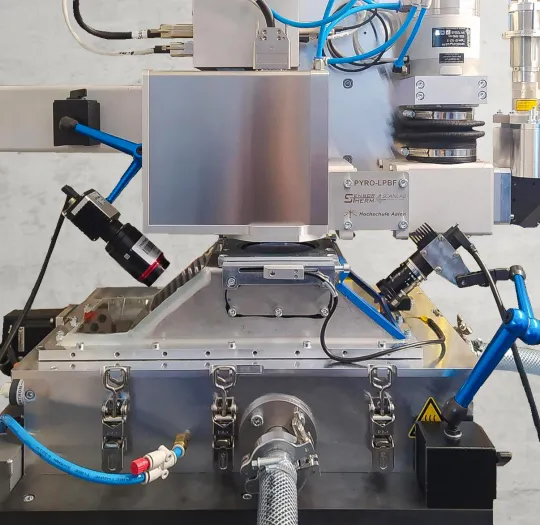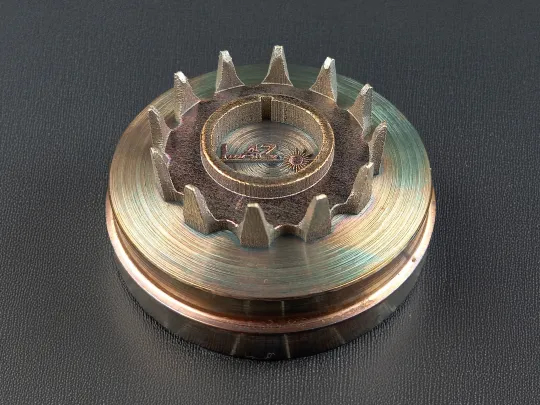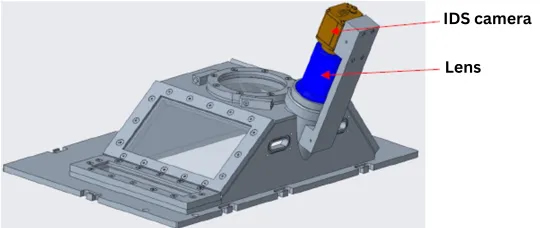Powder bed-based laser melting of metals (PBF-LB/M) is a key technology in additive manufacturing that makes it possible to produce highly complex and high-performance metal components with customised material and functional properties.
High-precision process monitoring and error detection in additive manufacturing
Case Study from | IDS Imaging Development Systems Inc.
Layer by layer
Powder bed-based laser melting of metals (PBF-LB/M) is a key technology in additive manufacturing that makes it possible to produce highly complex and high-performance metal components with customised material and functional properties. This technology is used in numerous industries - from aerospace and medical technology to the automotive industry - and is considered groundbreaking for the manufacturing of the future. Advances in process monitoring and control are crucial to further increasing the quality, reproducibility and efficiency of this manufacturing process.
A key challenge is the precise analysis of the layer-by-layer laser melting process, as this has a decisive influence on component quality. As part of research into increasing process stability and efficiency, students and scientific staff at the LaserApplicationCentre (LAZ) at Aalen University are conducting global, dynamic observation of the PBF-LB/M process. In the context of high-speed process control with temperature feedback, phenomena such as spatter and smoke formation, solidification behavior, and the safe movement of mechanical components during additive manufacturing are investigated. This is supplemented by a high-resolution, static analysis of the remelted component layer geometries and precise detection of potential defects in the powder layers in order to be able to draw well-founded conclusions about the resulting component quality. The imaging components of the research project are two high-performance USB3 industrial cameras from IDS Imaging Development Systems.

Test setup for additive manufacturing with the IDS camera U3-3040CP-C-HQ Rev.2.2 and the IDS camera U3-3990SE-M-GL Rev.1.2.
Two IDS industrial cameras provide the necessary image information
The two different tasks require different camera models. "We use a model from the USB3 uEye CP camera family for the global, dynamic observation of the PBF-LB/M process, such as splashes or the formation of smoke. A USB3 uEye camera from the SE series is used for the static, high-resolution identification of anomalies within the powder layers and in the remelted component layer geometries," explains David Kolb, research associate at the LAZ.
Requirements for the camera systems
The requirements for the two IDS camera systems are different due to their areas of application in the PBF-LB/M.
"Since powder bed-based laser beam melting of metals is a highly dynamic additive manufacturing process in which the component is generated layer by layer, the following features were particularly important for global, dynamic monitoring: The camera must offer a resolution of more than 1000 x 1000 pixels and a frame rate of more than 100 fps, cover an image field of at least 100 mm x 100 mm and have a trigger port for video recordings," says David Kolb, explaining the choice of camera model. The selected U3-3040CP-C-HQ Rev.2.2 enables excellent image quality even in low light or when the camera should take pictures of fast-moving objects. The integrated IMX273 global shutter CMOS sensor from Sony's Pregius range scores particularly well for its image quality, high sensitivity and wide dynamic range. With a resolution of 1.58 megapixels (1456 x 1088 px), it achieves a frame rate of 251 frames per second - ideal for detailed video and image analyses of dynamic processes.

Global process monitoring of the PBF-LB/M with different colour and exposure settings using the IDS camera U3-3040CP-C-HQ Rev.2.2 and the IDS peak software.

Additively manufactured soft magnetic stator half-shell of a transverse flux machine made of FeSi6.5 on a construction platform.
For static, high-resolution observation of powder layers or component layer geometries, on the other hand, the following camera properties are required in particular - in addition to a trigger port for single image recording: The sensor must be able to detect geometric features below 40 µm in order to identify defects in the layers and offer an image field of at least 100 mm × 100 mm and an image ratio that is as square as possible (1:1). This is exactly what the 20.36 megapixel (4512 x 4512 px) industrial camera U3-3990SE Rev.1.2 delivers. With the IMX541, it has a high-performance, extremely high-resolution, large-format 1.1" CMOS sensor from Sony's Pregius S series. The BSI technology ("Back Side Illuminated") used enables smaller pixels (2.74 µm) and a higher resolution, as well as improved quantum efficiency and sensitivity.

Design adjustments to the test setup for positioning the IDS camera U3-3990SE-M-GL Rev.1.2 for static observation of the powder component geometry layers.
"Thanks to the particularly user-friendly and flexibly integrable IDS cameras, the necessary adjustments to the test setup could be implemented quickly and easily so that the USB3 uEye SE can be positioned specifically at a defined angle," explains David Kolb. The near-vertical observation of the individual powder component geometry layers will provide valuable insights into component quality and potential manufacturing defects once the final adjustments have been completed. In this way, crucial information about the properties of additively manufactured components can be obtained and used specifically to optimise the manufacturing processes.
Outlook
Research in the field of PBF-LB/M is essential for the development and processing of new material alloys and the production of performance-enhancing, sometimes multi-material component geometries. An in-depth understanding of the process helps to minimise defects and realise innovative designs that would not be possible using conventional production methods. The IDS cameras provide in-depth insights into the PBF-LB/M and thus make a valuable contribution to research, development and transfer (R&D&T) - for example in the processing of new material alloys or the production of complex, application-optimised (multi-material) components.
In future, artificial intelligence will be used to automatically analyse the dynamic and static observation of the PBF-LB/M. The aim is to gain an even better understanding of the highly dynamic laser-material interaction - such as the number and trajectory of spatter and the formation of process errors - and to further improve the additive manufacturing process in terms of resource efficiency and sustainability.
The content & opinions in this article are the author’s and do not necessarily represent the views of RoboticsTomorrow

IDS Imaging Development Systems Inc.
World-class image processing and industrial cameras "Made in Germany". Machine vision systems from IDS are powerful and easy to use. IDS is a leading provider of area scan cameras with USB and GigE interfaces, 3D industrial cameras and industrial cameras with artificial intelligence. Industrial monitoring cameras with streaming and event recording complete the portfolio. One of IDS's key strengths is customized solutions. An experienced project team of hardware and software developers makes almost anything technically possible to meet individual specifications - from custom design and PCB electronics to specific connector configurations. Whether in an industrial or non-industrial setting: IDS cameras and sensors assist companies worldwide in optimizing processes, ensuring quality, driving research, conserving raw materials, and serving people. They provide reliability, efficiency and flexibility for your application.
Other Articles
Inspection of critical infrastructure using intelligent drones
Multi-camera system with AI and seamless traceability leaves no chance for product defects
Automate 2025 Q&A with IDS Imaging
More about IDS Imaging Development Systems Inc.
Featured Product

